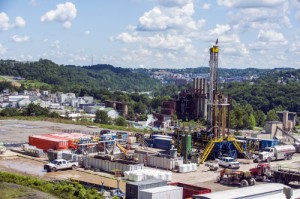WVU researchers discover nearby Marcellus shale process safer than others
From an Article by Sunshine Wiles, WAJR News, July 20, 2016
Morgantown, WV — WVU researchers have studied waste from two hydraulic fracturing wells near Morgantown.
The findings were shared Wednesday at the Appalachian Basin Technology Workshop in Canonsburg, Pennsylvania.
“When you drill a Marcellus well, you produce water. You produce solid waste. We’re trying to find out whether they are innocuous or whether they’re harmful to the environment and if they are how best to handle them so they are isolated from any environmental impact,” explained Paul Ziemkiewicz, director of the West Virginia Water Research Institute at WVU.
Northeast Natural Energy allowed WVU and Ohio State researchers unprecedented access to two active and producing well sites just outside Morgantown.
“We actually got samples as all of these processes were taking place. During the drilling process, we got access to all of the drill cuttings that were coming back up out of the well, the drilling mud. We were able to analyze those,” Ziemkiewicz said on MetroNews Talkline with Hoppy Kercheval.
The researchers, working through the Marcellus Shale Energy and Environmental Laboratory, were looking for organic compounds and radioactive elements. Both do occur naturally 6,000 feet below the earth’s surface.
“At these depths you get things that just haven’t seen the light of day since the dawn of time. They haven’t weathered. And, when you introduce water and bring them up to the surface, you get all kinds of compounds that you normally wouldn’t see,” Ziemkiewicz mentioned.
Researchers were able to characterize that salt levels go up dramatically mainly consisting of sodium chloride. They closely monitored toxic organic compounds, like benzene, as well.
“What we found is that the concentration coming back from these two wells is very low. Only one actually exceeded drinking water standards. That was benzene and just barely.”
Cuttings and samples analyzed for radio activity and hazardous compounds from further west in Ohio found drill cuttings severely contaminated with hazardous waste.
Extractions from the Northeast Natural Energy wells are carried out using BioBase 365, a synthetic mud. “It looks like the big controlling factor on whether the drill cuttings are hazardous or toxic or not is what kind of drilling mud you use. It’s not the drill cuttings themselves, at least in these two wells, that are hazardous,” summarized Ziemkiewicz.
The researcher said the synthetic mud is called a “green completion fluid” and is just coming on the horizon. Meanwhile, drilling companies have to comply with national regulations when transporting toxic well compounds.
Ziemkiewicz said the waste water is toxic and must be handled with care when transporting it for disposal.If that water is mixed with solid waste left in ponds or tanks, it can be even more dangerous to transport.
“If you use a method or drilling mud that doesn’t create toxic drilling muds and you keep those separate from hazardous materials like tank bottoms, I think you’ve got the potential for a relatively inert material that could be disposed of carefully obviously but it doesn’t have to be treated like a toxic waste,” concluded Ziemkiewicz.
The research of shale gas resources from beginning-to-end is the first long-term study of its kind.
See also: www.FrackCheckWV.net

